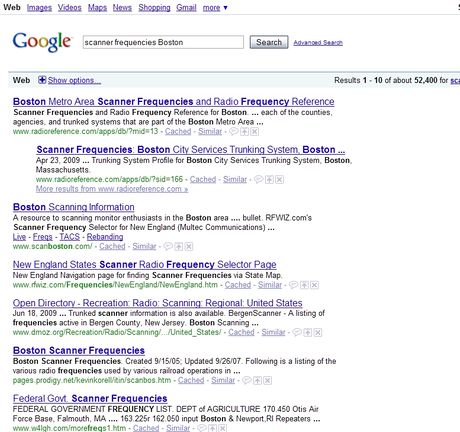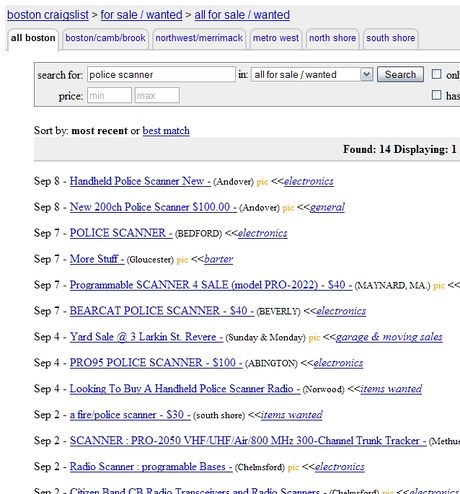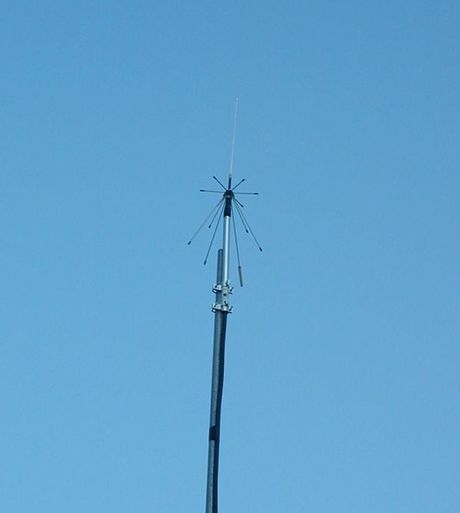Use a scanner radio to listen to all types of Public Service, Police, Fire, EMS, Government, Ham (and many other types, too) of radio transmissions and broadcasts. There are many types of scanners from which to choose. Prices range from under $50 for a used conventional scanner to others that cost well in excess of $400 for digital voice / triple trunk tracking types. Read on for more information.
Steps1Determine service types of interest. Police, Fire and EMS are popular choices, but there are many others as well such as race, rail and air traffic control. As time goes on more law enforcement agencies are migrating from old analog systems to newer digital transmissions that can increase scanner radio costs significantly to decode properly. If those agencies are of little interest – a great deal of money can be saved. 2Obtain a list of frequencies used in areas of interest. Purchase a scanner frequency directory from Radio Shack or book store. These books are often sold by region of interest and may also be further reduced in size instead of displaying all licensed services (taxicab, business, ham, etc.) to just police, fire & EMS services. Google is also great free source for this information. A Google search for “scanner frequencies Boston” results in a number of links for Boston, MA. Substitute your city or town, county or state for “Boston” in the search box.Advertisement
2Obtain a list of frequencies used in areas of interest. Purchase a scanner frequency directory from Radio Shack or book store. These books are often sold by region of interest and may also be further reduced in size instead of displaying all licensed services (taxicab, business, ham, etc.) to just police, fire & EMS services. Google is also great free source for this information. A Google search for “scanner frequencies Boston” results in a number of links for Boston, MA. Substitute your city or town, county or state for “Boston” in the search box.Advertisement 3Review the frequencies. If the services in the area(s) of interest have frequencies in the 800 Mhz (MHz = megahertz) range, additional options will likely be required to listen to those services. More on this later in the 800 Mhz section.
3Review the frequencies. If the services in the area(s) of interest have frequencies in the 800 Mhz (MHz = megahertz) range, additional options will likely be required to listen to those services. More on this later in the 800 Mhz section. 4Review scanner radios offered for sale. There is probably a Radio Shack store (or similar) fairly close to just about everyone and these are great places to at least view and hold these radios. Unfortunately, few Radio Shack stores have personnel that really know about scanners, and may not be a very good source for information. Do your own investigation and compare features, costs, available options, etc.5Learn the lingo. Look up terms and phrases used in the features of the scanner. Most radios offer one or more bands of tuning: 25 – 30 MHz CB & 10 Meter Ham Band, 30 – 50 MHz VHF Low Band, 50 – 54 MHz 6 Meter Ham Band, 88 – 108 MHz Commercial FM, 108 – 137 MHz Aircraft Band (AM mode), 137 – 144 MHz Federal Government, 144-148 MHz 2 Meter Ham Bands, 148 – 174 MHz VHF High Band, 216 – 405 MHz UHF Military Air Band, 406 – 420 MHz Federal Government, 420 – 450 MHz 70 centimeter (27.6 in) Ham Band, 450 – 470 MHz UHF Band, 470 – 512 MHz UHF “T” Band, 764 – 775 MHz 794 – 806 MHz and 806 – 960 MHz 800 MHz Band (no cellular) and lastly, 1.24 – 1.3 GHz Ham Band. Some examples below:If interested in monitoring Boston’s Logan International Airport Approach frequency on 133.0Mhz, the radio must be capable of AM mode (not NFM type used by most other services or WFM for commercial broadcasters) and tuning the 133.0 MHz frequency.If interested in listening to commercial FM broadcasters, the radio will need to be able to tune 88 MHz through 108 MHz in WFM (Wide band FM)If interested in listening to Police on 42.4 MHz, or 460.15 MHz, etc. the radio will need to be capable of tuning the frequency and the very common NFM (Narrow band FM) mode.If given an older non-programmable scanner, it is likely tuned by crystals. Years ago, crystals were available for purchase by specific frequency. If 42.40 Mhz was to be monitored, a 42.40 MHz crystal (sometimes called “rocks”) needed to be purchased and installed into an open jack in the radio. If 8 channels were to be scanned, it would require 8 crystals. About $5 to $7 was an average price for a single crystal, so quite a few dollars could be spent just for frequencies. Moving to a new city would probably require buying a whole new set of crystals. Thankfully, programmable radios put an end to the crystal radio.6
4Review scanner radios offered for sale. There is probably a Radio Shack store (or similar) fairly close to just about everyone and these are great places to at least view and hold these radios. Unfortunately, few Radio Shack stores have personnel that really know about scanners, and may not be a very good source for information. Do your own investigation and compare features, costs, available options, etc.5Learn the lingo. Look up terms and phrases used in the features of the scanner. Most radios offer one or more bands of tuning: 25 – 30 MHz CB & 10 Meter Ham Band, 30 – 50 MHz VHF Low Band, 50 – 54 MHz 6 Meter Ham Band, 88 – 108 MHz Commercial FM, 108 – 137 MHz Aircraft Band (AM mode), 137 – 144 MHz Federal Government, 144-148 MHz 2 Meter Ham Bands, 148 – 174 MHz VHF High Band, 216 – 405 MHz UHF Military Air Band, 406 – 420 MHz Federal Government, 420 – 450 MHz 70 centimeter (27.6 in) Ham Band, 450 – 470 MHz UHF Band, 470 – 512 MHz UHF “T” Band, 764 – 775 MHz 794 – 806 MHz and 806 – 960 MHz 800 MHz Band (no cellular) and lastly, 1.24 – 1.3 GHz Ham Band. Some examples below:If interested in monitoring Boston’s Logan International Airport Approach frequency on 133.0Mhz, the radio must be capable of AM mode (not NFM type used by most other services or WFM for commercial broadcasters) and tuning the 133.0 MHz frequency.If interested in listening to commercial FM broadcasters, the radio will need to be able to tune 88 MHz through 108 MHz in WFM (Wide band FM)If interested in listening to Police on 42.4 MHz, or 460.15 MHz, etc. the radio will need to be capable of tuning the frequency and the very common NFM (Narrow band FM) mode.If given an older non-programmable scanner, it is likely tuned by crystals. Years ago, crystals were available for purchase by specific frequency. If 42.40 Mhz was to be monitored, a 42.40 MHz crystal (sometimes called “rocks”) needed to be purchased and installed into an open jack in the radio. If 8 channels were to be scanned, it would require 8 crystals. About $5 to $7 was an average price for a single crystal, so quite a few dollars could be spent just for frequencies. Moving to a new city would probably require buying a whole new set of crystals. Thankfully, programmable radios put an end to the crystal radio.6 How many channels? As mentioned above, programmable radios replaced the crystal radios of years ago. Digital programming made having 50, 100 and even 1,000 channel radios inexpensive to own. A simple memory location programmed with a frequency that could be entered by the keyboard made programming free – but sometimes a bit more cumbersome. Managing more than a dozen or so frequencies can become challenging. So much so, that some radios come with or offer as an option, hardware and / or software that allows near painless programming via computer. The larger the number of frequencies programmed into the radio, the more desirable this option becomes. An added plus is the ability to add a 6 (or more) character alpha-numeric to provide a name for the frequency.7Find the Search and speed capabilities. Google located a bunch of frequencies in your area. A scanner book provided even more. But is that all there is? Absolutely not. Many frequencies aren’t listed. Some because they are not licensed – others because they are clandestine and others still – because they weren’t included in the directory or no one has found them yet. The ability to scan all frequencies in a range is a helpful tool to locate unpublished users of frequencies. When scanning a range – or even those saved in the scanner, the ability to scan at a very high rate of speed is helpful. Assume that even if there were no transmissions, it took a minute or two to scan from channel 1 to channel 100 and start again, how many transmissions were not heard on channel 134? The scan stayed on each channel about 1/2 second, but if it stayed only 1/10 sec, it could have scanned all the channels five times instead of just once.
How many channels? As mentioned above, programmable radios replaced the crystal radios of years ago. Digital programming made having 50, 100 and even 1,000 channel radios inexpensive to own. A simple memory location programmed with a frequency that could be entered by the keyboard made programming free – but sometimes a bit more cumbersome. Managing more than a dozen or so frequencies can become challenging. So much so, that some radios come with or offer as an option, hardware and / or software that allows near painless programming via computer. The larger the number of frequencies programmed into the radio, the more desirable this option becomes. An added plus is the ability to add a 6 (or more) character alpha-numeric to provide a name for the frequency.7Find the Search and speed capabilities. Google located a bunch of frequencies in your area. A scanner book provided even more. But is that all there is? Absolutely not. Many frequencies aren’t listed. Some because they are not licensed – others because they are clandestine and others still – because they weren’t included in the directory or no one has found them yet. The ability to scan all frequencies in a range is a helpful tool to locate unpublished users of frequencies. When scanning a range – or even those saved in the scanner, the ability to scan at a very high rate of speed is helpful. Assume that even if there were no transmissions, it took a minute or two to scan from channel 1 to channel 100 and start again, how many transmissions were not heard on channel 134? The scan stayed on each channel about 1/2 second, but if it stayed only 1/10 sec, it could have scanned all the channels five times instead of just once.
8Decide what type of radio you want. A base, mobile or portable radio? This is largely a matter of personal preference. Some places however, restrict the usage of scanners in vehicles. Be sure to check with local authorities in your area before installing such a radio in a vehicle. Technology in power conservation and battery life have made portable scanning more desirable than ever. But carrying such a radio will often draw looks, questions and even theft. Obviously, using a portable radio should be used with an earphone – which can make understanding transmissions even more difficult. Some portables are geared towards auto racing fans, these radios make it easy to assign a channel with a team’s frequency and labeling as the car number – making identification that much easier. Base radios not have to worry about batteries failing as they are plugged directly into an outlet. Audio on base units are usually superior to portables as the speaker is usually much larger and has more power available to it. Displays are usually lit the entire time and for the most part offer more memory locations to store frequencies and even alpha-numeric tagging with the name of the service such as BOSTON PD F2 OPS (Boston PD F2 Operations), rather than just displaying 460.4500 (some portables support alpha-numeric tagging, too). 9Maximize reception. You can’t listen if you can’t hear it. Nearly all of these radio types can have the supplied antenna changed to one that will perform better. Keys points to remember are to have the antenna up as high as possible and keep a high quality / low loss feed line or coax cable between the antenna and radio as short as possible. Choose an antenna that is “matched” to the frequency bands programmed. If the radio only has VHF-Low and VHF-High frequencies and an antenna that is designed for UHF and 800 MHz, changing to a VHF-Low antenna should improve reception. Mismatched antennas will probably not affect local services adversely, but could make the difference when trying to monitor services 2,3 or more communities away.10Make sure that you have audio output and tape recorder control jacks if condensing all transmissions received. Some scanners provide for the control of a tape recorder. When a scan is stopped, the radio closes a switch that starts an external tape recorder in record mode. When scanning resumes, the recorder stops until the next time. An entire day’s of transmissions could be reduced to an hour or two of seemingly non-stop dialog.Advertisement
9Maximize reception. You can’t listen if you can’t hear it. Nearly all of these radio types can have the supplied antenna changed to one that will perform better. Keys points to remember are to have the antenna up as high as possible and keep a high quality / low loss feed line or coax cable between the antenna and radio as short as possible. Choose an antenna that is “matched” to the frequency bands programmed. If the radio only has VHF-Low and VHF-High frequencies and an antenna that is designed for UHF and 800 MHz, changing to a VHF-Low antenna should improve reception. Mismatched antennas will probably not affect local services adversely, but could make the difference when trying to monitor services 2,3 or more communities away.10Make sure that you have audio output and tape recorder control jacks if condensing all transmissions received. Some scanners provide for the control of a tape recorder. When a scan is stopped, the radio closes a switch that starts an external tape recorder in record mode. When scanning resumes, the recorder stops until the next time. An entire day’s of transmissions could be reduced to an hour or two of seemingly non-stop dialog.Advertisement








